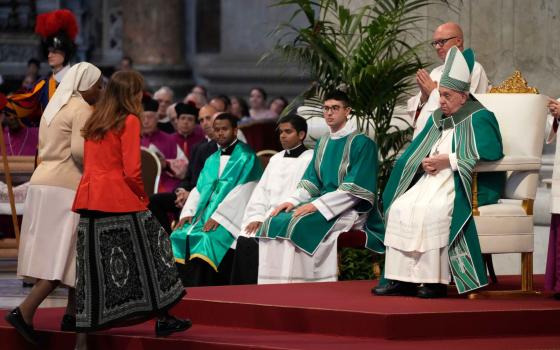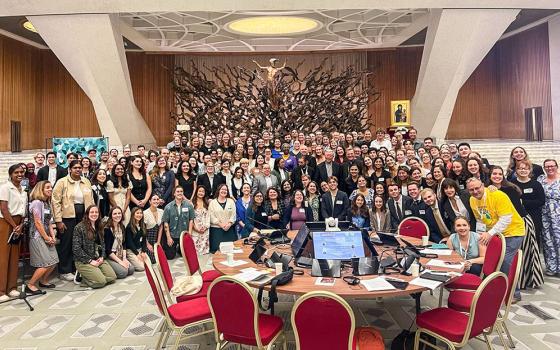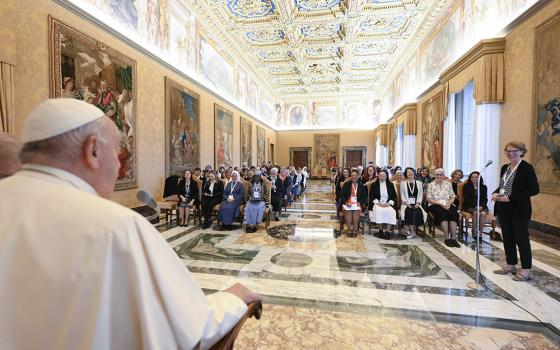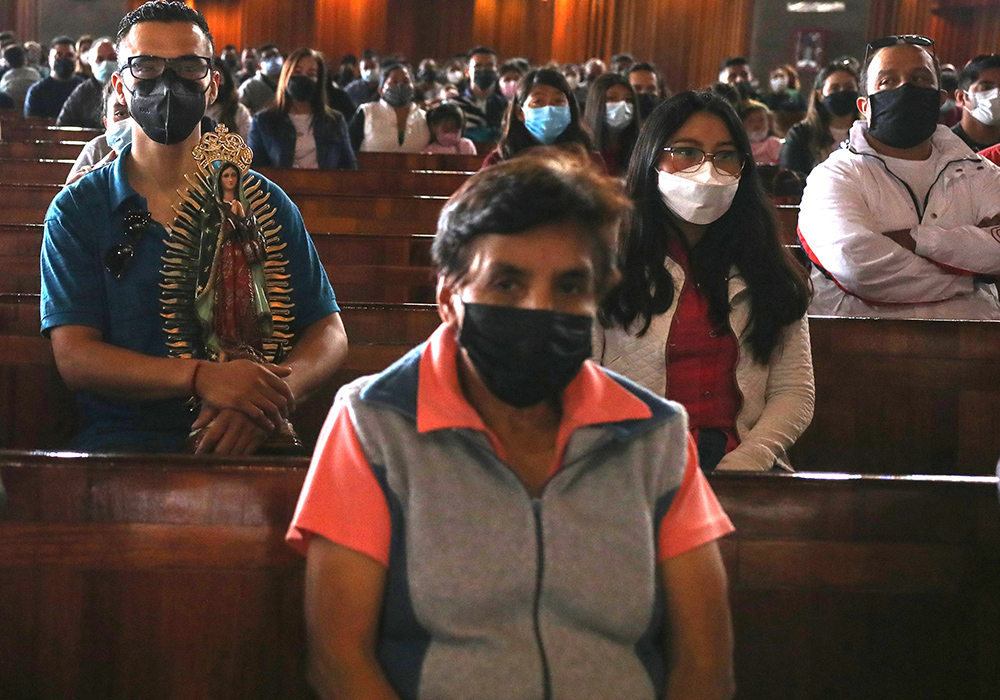
A man holds a statue of Our Lady of Guadalupe during Mass at the opening of the Sixth Ecclesial Assembly of Latin America and the Caribbean at the Basilica of Our Lady of Guadalupe Nov. 21, 2021, in Mexico City. The assembly followed five general conferences of Latin American and Caribbean bishops. Latin American and U.S. Latino theologians recognize influences from the pope's Latin American roots in the upcoming two-part synod process. (CNS/Emilio Espejel)
As the first gathering of Pope Francis' highly anticipated Synod of Bishops is set to begin on Oct. 4, Latin American and U.S. Latino theologians are recognizing influences from the pope's Latin American roots in the theology and methodology behind this first-of-its-kind two-part synod process.
With this synod gathering, Francis has introduced groundbreaking changes to the synod format, most notably adding laypeople, including women, as full voting members of the assembly for the first time.
The working document for the synod, known formally as the instrumentum laboris and released June 20, also debuted a new change, featuring many open-ended questions for synod members to consider during the Oct. 4-29 assembly, instead of being simply a draft of the synod's final document, which had been the previous format.
The Latin American bishops' council, commonly known by the Spanish-language acronym CELAM, has long prioritized this type of broad consultation and open-ended discussion.
Before he became Pope Francis, Argentine Cardinal Jorge Bergoglio played a pivotal role in drafting the final document of CELAM's Fifth General Conference of Bishops of Latin America and the Caribbean, held in Aparecida, Brazil, in May 2007.
Maria Clara Lucchetti Bingemer, a theology professor at the Pontifical Catholic University of Rio de Janeiro, was invited to Aparecida with other Brazilian theologians to advise the bishops outside of their sessions.
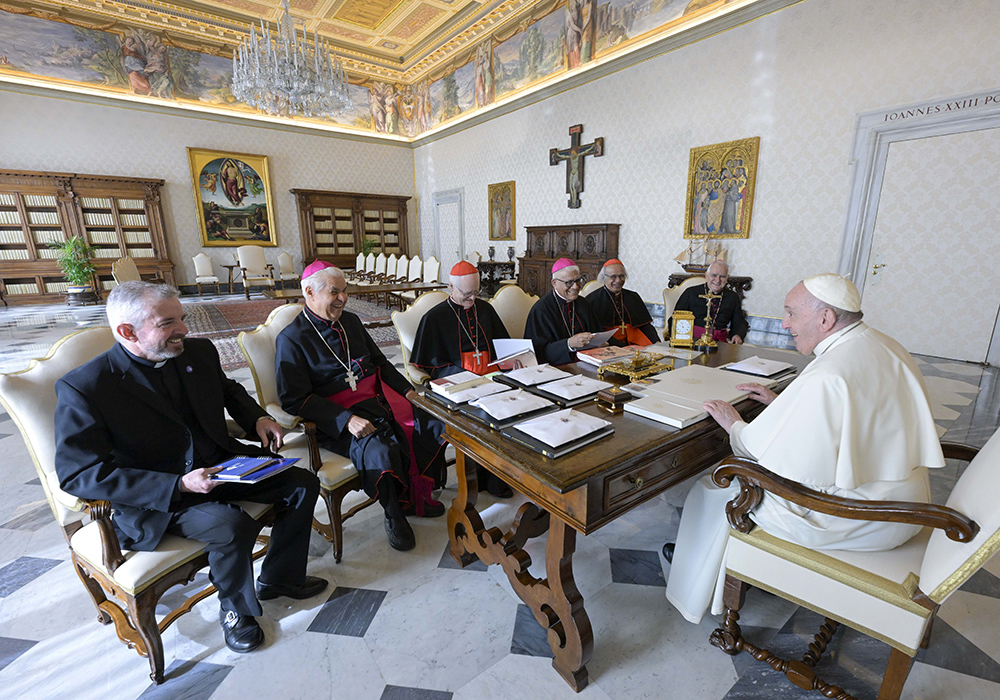
Pope Francis meets with leaders of the Latin American bishops' council, or CELAM, in the library of the Apostolic Palace at the Vatican Oct. 31, 2022. From the left: Fr. Pedro Manuel Brassesco; Archbishop Rogelio Cabrera López of Monterrey, Mexico; Cardinal Odilo Pedro Scherer of São Paulo; Archbishop Héctor Cabrejos Vidarte of Trujillo, Peru; Cardinal Leopoldo Brenes Solórzano of Managua, Nicaragua; and Archbishop Jorge Eduardo Lozano of San Juan de Cuyo, Argentina. (CNS/Vatican Media)
She remembers that, although no one at the time suspected Bergoglio would become pope, his "capacity of leadership" as chair of the committee drafting the final document was evident.
Bingemer said Bergoglio kept a tight rein on the drafting process for the document, making sure the text contained "all the important things" exactly "as it was planned." The final version, which took a see-judge-act model in looking at the current needs of the church and wider world, was widely praised.
Hosffman Ospino, associate professor of Hispanic ministry and religious education at Boston College, said that, in this synod, Francis is lifting up a model of "situated collegiality," a type of collegiality where the ministry of bishops is "grounded in the geographically specific community of baptized people that they serve, the particular church, not just the fact that they are ordained."
" 'Situated collegiality' has characterized CELAM from its beginnings in 1955" in Rio de Janeiro, and it was "explicitly named" in the 1968 Medellín conference document, said Ospino.
Collegiality is a term that had previously been used only to refer to the relationship between the pope and the various bishops of the world, as they govern the church.
Rafael Luciani, a theological expert for the Synod of Bishops and for CELAM and an associate professor of theology at Boston College, said that CELAM's general conferences, like its first one in Rio de Janeiro, which took place before the Second Vatican Council, used an ecclesiological framework that emphasizes collaboration among local churches.
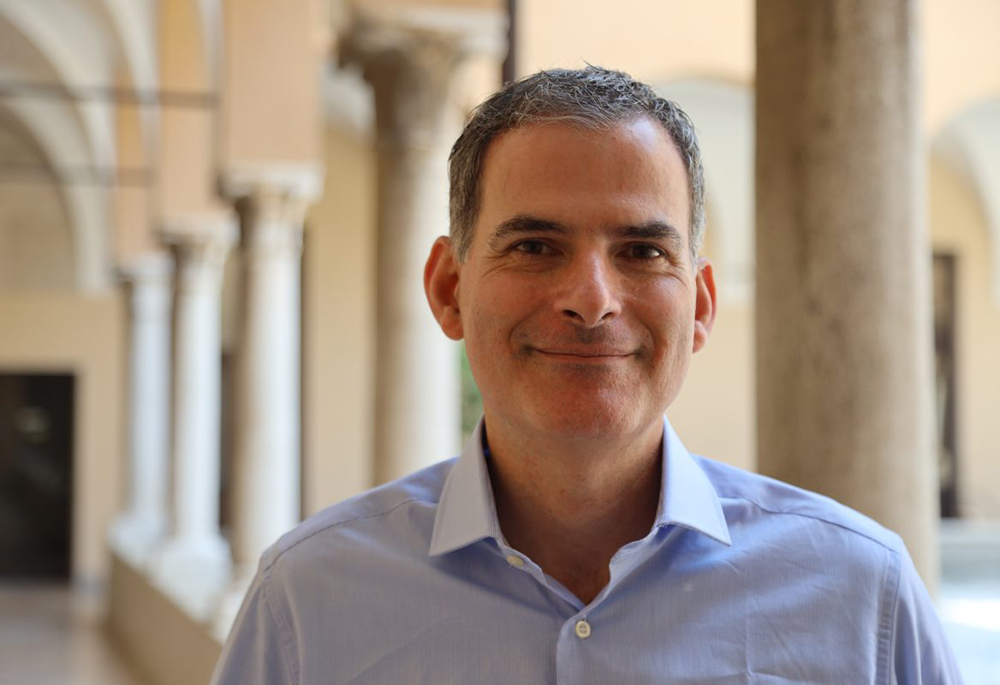
Rafael Luciani, a theological expert for the Synod of Bishops and for CELAM, and an associate professor of theology at Boston College (Courtesy of Rafael Luciani)
Luciani said that this ecclesiology was a theme throughout Vatican II, where it influenced the dogmatic constitution Lumen Gentium, which in turn influenced subsequent CELAM general conferences, including Aparecida, where Bergoglio took a leading role.
Jesuit Fr. Allan Figueroa Deck, a distinguished scholar in pastoral theology and Latino studies at Loyola Marymount University, said that Francis' ideas about reform had been "percolating" in Latin America for over 50 years.
"There's a long period of formation or gestation, whatever you want to call it, of the vision of renewal based on the spirit of Vatican II that was developed in Latin America, and it was the only place in the world in the Catholic world where that vision was as fully developed," said Deck.
"The high point now of this process in my view is the synodal pathway that Pope Francis is proposing," Deck said.
Luciani agreed with Ospino that Francis is drawing on a particularly Latin American version of collegiality. He said that we are living through "the transition from an episcopal collegiality towards a synodal collegiality," where a bishop speaks as a representative of a diocese and a local church, as opposed to speaking as an individual.

Hosffman Ospino, associate professor of Hispanic ministry and religious education at Boston College (CNS/Boston College/Lee Pellegrini)
Within "synodal collegiality," Luciani said that bishops must listen not only to each other, but also to the rest of the faithful through consultative processes.
This transition is not comfortable for some bishops outside of Latin America, but this type of collegiality is normal throughout that region of the world, said Luciani.
Ospino, a native of Colombia, remembered going to an ecclesial assembly that was called by his bishop when Ospino was just 14 years old, where a broad diversity of Catholics in his diocese participated.
Before each of CELAM's five general conferences, local bishops carried out a consultation of their people about what they saw as the needs of the church at the time.
Luciani remembered that before the Aparecida meeting in 2007, "in Venezuela, all the newspapers published a questionnaire that everyone could just fill out and send to the episcopal conference."
Another key concept influencing the synod is "pastoral conversion," theologians said. "Pastoral conversion" was first mentioned in the final document from CELAM's conference in Santo Domingo in the Dominican Republic in 1992, just months after Bergoglio became auxiliary bishop of Buenos Aires.
The Santo Domingo document describes pastoral conversion as a conversion that impacts everyone "in their conscience, in personal and community praxis, in relationships of equality and authority."
In 2007, with Bergoglio at the helm as cardinal of Buenos Aires, this one-sentence concept expanded significantly to include an entire section about "pastoral conversion" in the Aparecida document.
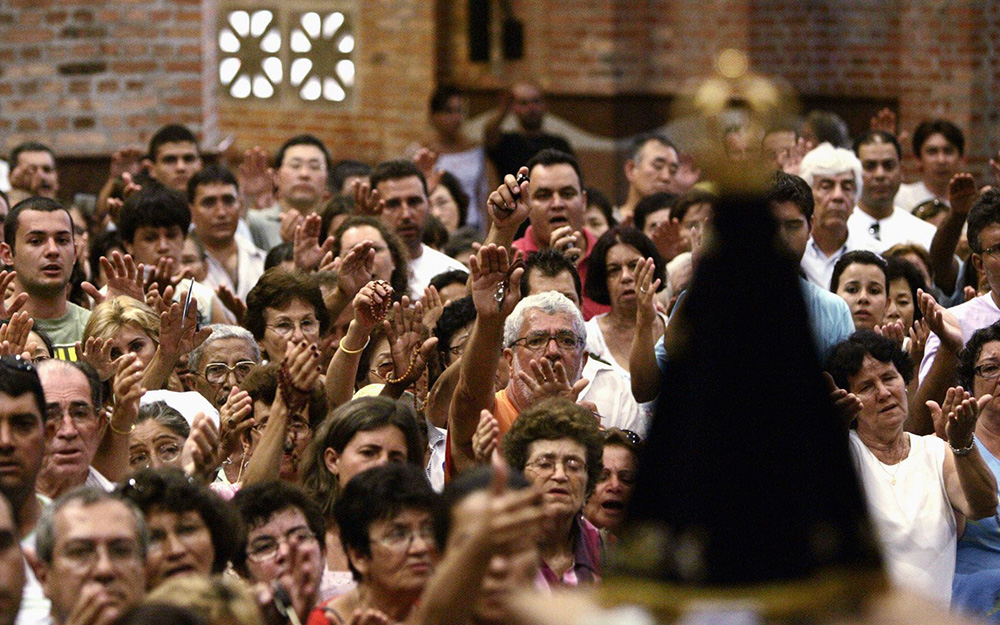
Catholics pray in the basilica Feb. 2, 2007, in Aparecida, Brazil. Before he became Pope Francis, Argentine Cardinal Jorge Bergoglio played a pivotal role in drafting the final document of CELAM's Fifth General Conference of Bishops of Latin America and the Caribbean, held in Aparecida, in May 2007. (CNS/Reuters/Paulo Whitaker)
This section of the Aparecida document says it draws inspiration from early Christian communities, the ecclesiology of the Second Vatican Council, the "synodal path" in the post-council era and the previous CELAM general conferences.
By becoming "missionary disciples" through "pastoral conversion," the document says that "an attitude of openness, dialogue and availability to promote co-responsibility and effective participation of all the faithful in the life of Christian communities" is born.
"The laity should participate in discernment, decision making, planning and execution," the 2007 document says.
The "pastoral conversion" concept appears again in Francis' 2013 apostolic exhortation Evangelii Gaudium, which was called a "road map" to his papacy as it was published at the beginning of a pontificate that would later focus on synodality.
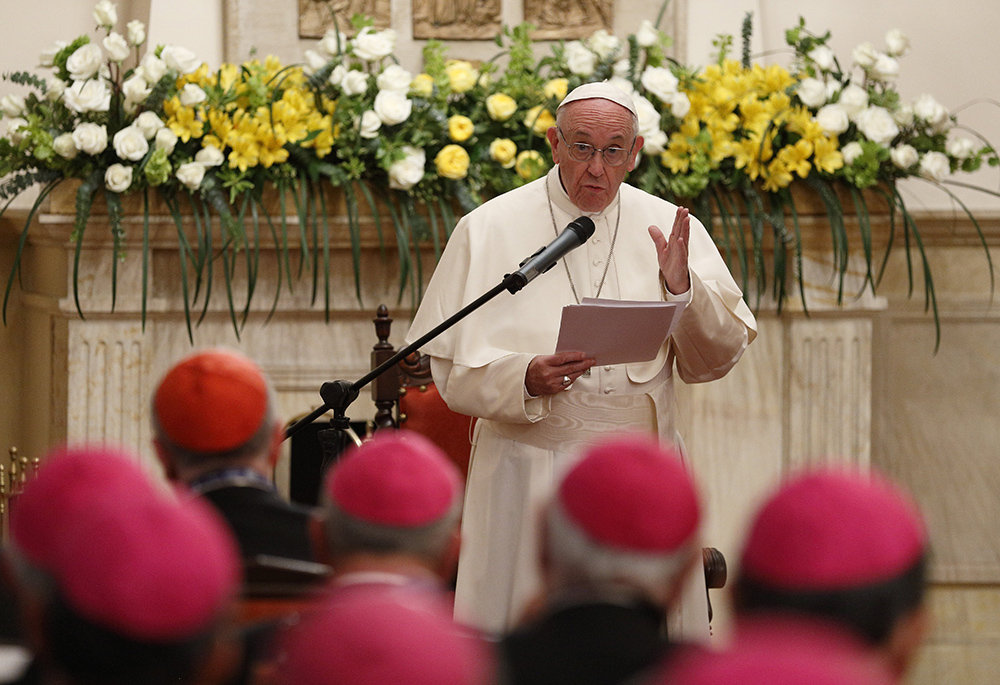
Pope Francis addresses the executive committee of the Latin American bishops' council, or CELAM, at the apostolic nunciature Sept. 7, 2017, in Bogota, Colombia. As archbishop of Buenos Aires, he led the committee that drafted the final document of the council's 2007 meeting in Aparecida, Brazil. (CNS/Paul Haring)
Bingemer also recognizes an influence of Aparecida in Francis' repeated invocation of the need for Christians to be "missionary disciples" as he talks about the synod. The theme of the Aparecida general conference was "Disciples and Missionaries of Jesus Christ, so that our peoples may have life in him."
In addition to the Latin American influence on the synod, Deck also said that U.S. Latinos had developed "the synodal vision" in the U.S. Catholic Church "more than any other group" through five Encuentros, or national consultative processes of U.S. Hispanic Catholics.
"What a synodal approach to being church, what it means is inviting everybody to come in, listening to everybody, and having ways to process what you hear," Deck said, explaining that this synodal process has been at the heart of the Encuentros, which also emphasized the "evangelizing and mission character of the church" and "going out to those on the margins."
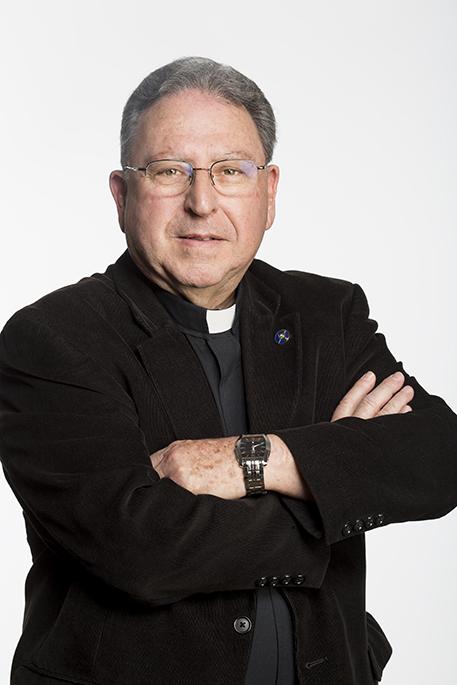
Jesuit Fr. Allan Figueroa Deck, a distinguished scholar in pastoral theology and Latino studies at Loyola Marymount University (Courtesy of Allan Figueroa Deck)
Deck also highlighted the surveys that the Encuentros have done, similar to the widespread consultation that has occurred in the current Synod of Bishops process. V Encuentro or the Fifth National Encuentro surveyed Catholic Latinos in ministry to prepare diocesan, regional and national reports.
Francis' willingness to experiment in the current synod is indicative of the level of "spiritual freedom and trust in the Holy Spirit" in the relatively young church in Latin America, Ospino said.
His groundbreaking decision to allow women delegates to vote in this synod can be also understood in light of Francis' Latin American roots.
"The church in Latin America was very open in social terms, but in terms of personal ethics, sexuality, gender, not so much," said Bingemer, saying Francis "was a fruit of this context."
At the same time, "as a priest, as bishop, he had a lot of female friends," said Bingemer, even assisting one woman at great personal risk during Argentina's military dictatorship.
In Francis' decision to create a more open-ended working document for the synod, Bingemer sees the influence of Latin American ecclesial base communities, who she said have "a horizontal model of being church" and worship in small groups.
However, theologians also say that there are completely new concepts at play during this synod, including what Luciani identifies as "restitutio," a concept present in Cardinal Mario Grech's suggestion at the inauguration of the three-year synod process in 2021 that the synodal assembly's conclusions should be returned to various local churches so that both bishops and the people of God can consent to those conclusions.
Luciani said that this concept of "restitutio" was also present in the continental stage documents, in which local churches received what the people of God throughout the world had said.
Advertisement
From the very beginning of the papacy, when Francis introduced himself to the crowds outside St. Peter's Square as the new bishop of Rome in March 2013, through his work on synodality, Bingemer says Francis has emphasized decentralization that gives "more weight to episcopal conferences."
Francis "brings the colonized point of view" and the diversity that comes with it, said Bingemer. "The reconciling with this diversity is one of the fundamental points of the legacy of this pontificate. That comes from the Latin American background of the pope," she said.
Ospino said that "the Latin American ecclesial experience is crucial" not only for understanding the theological and methodological commitments of the current synod, but also for framing its purpose.
Coming from a Latin American perspective, Ospino said that the ongoing synod is like a family dinner where "many people gather as one to celebrate each other's sacred presence despite their differences," as opposed to the political battle of wills that U.S. and Western European observers might perceive it to be.
"We're moving all together towards a new institutional model," Luciani said.
Deck said: "For the first time in history, the church in Latin America, which is five centuries old, has become the source of renewal for the entire church."




